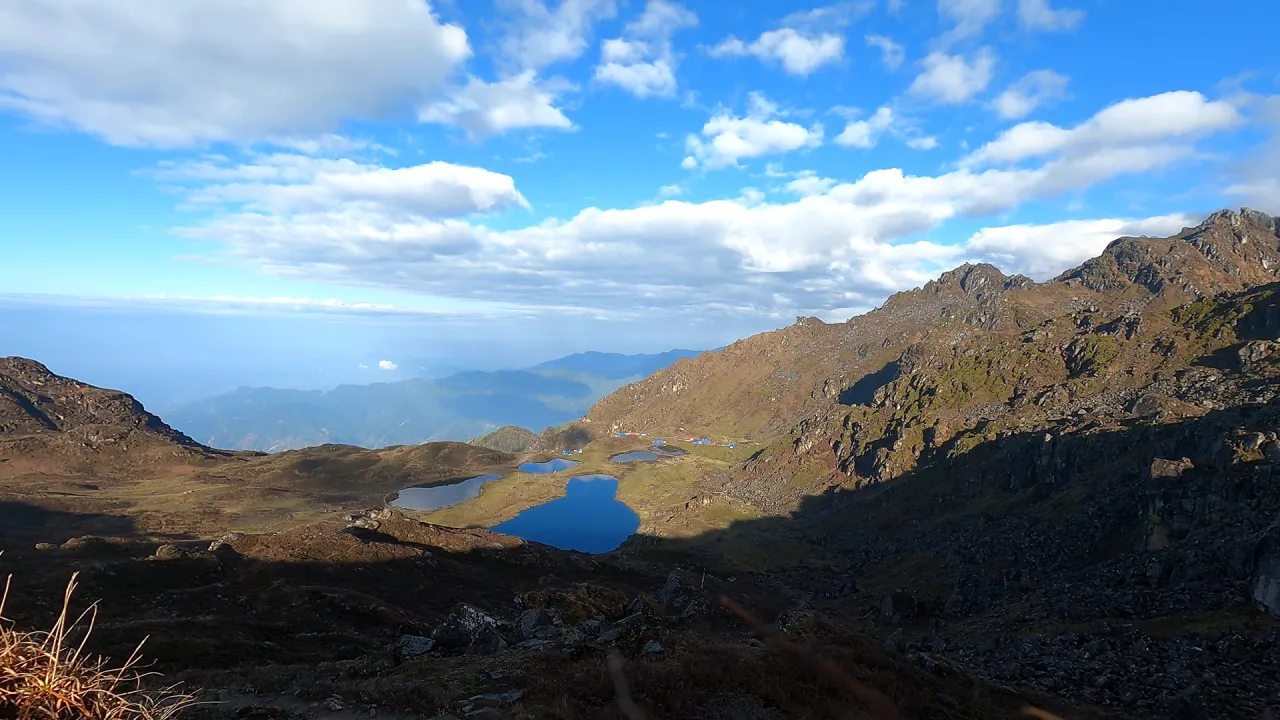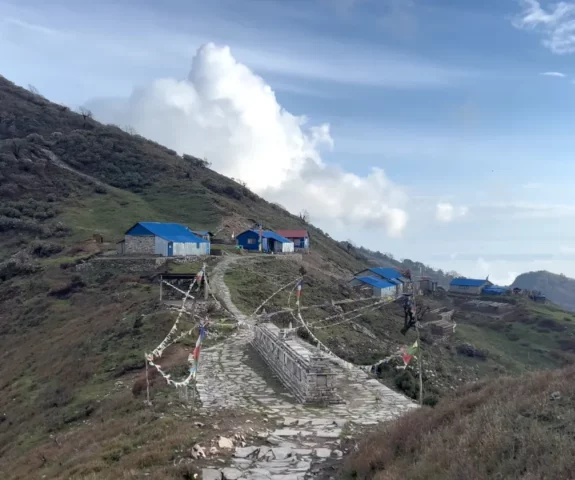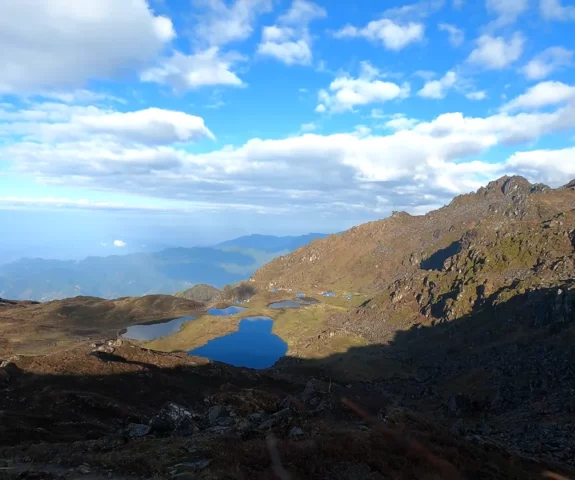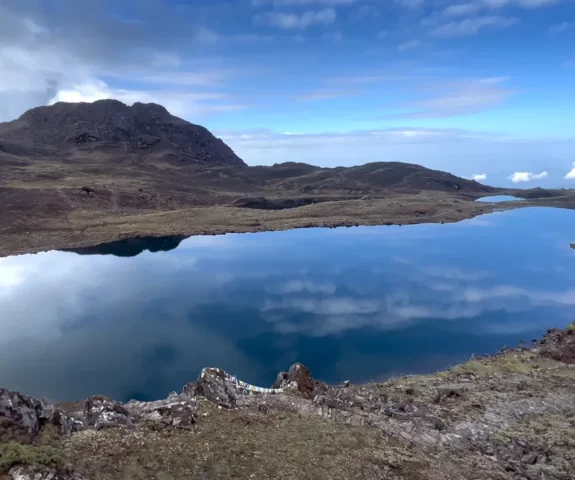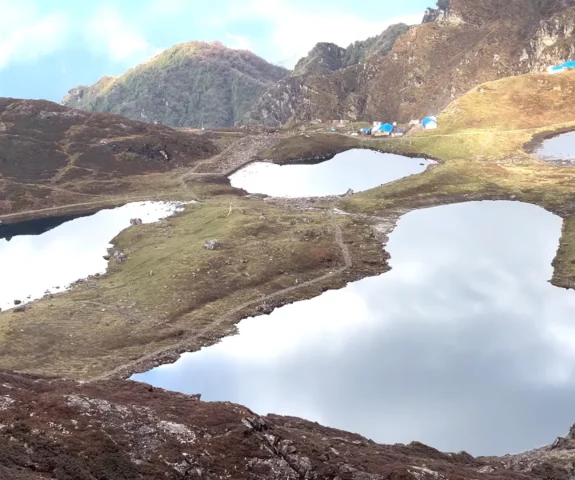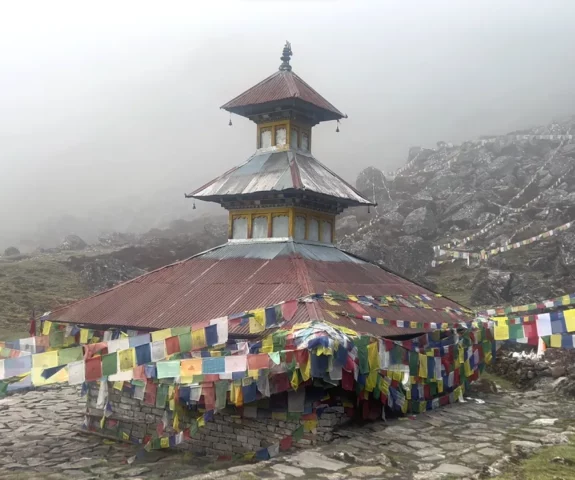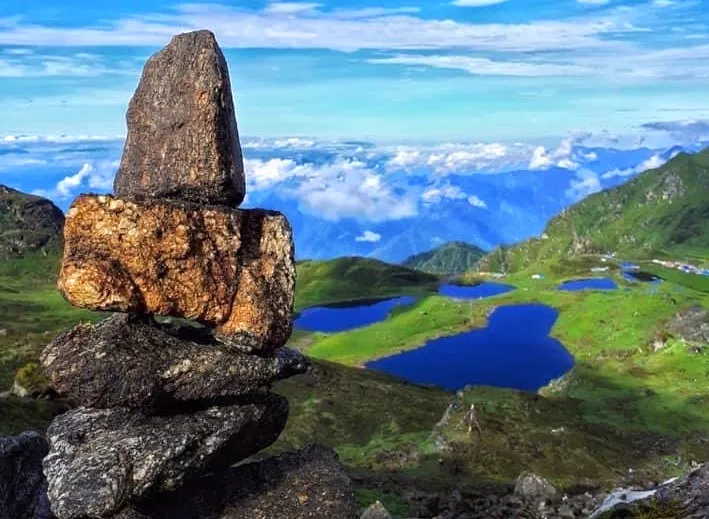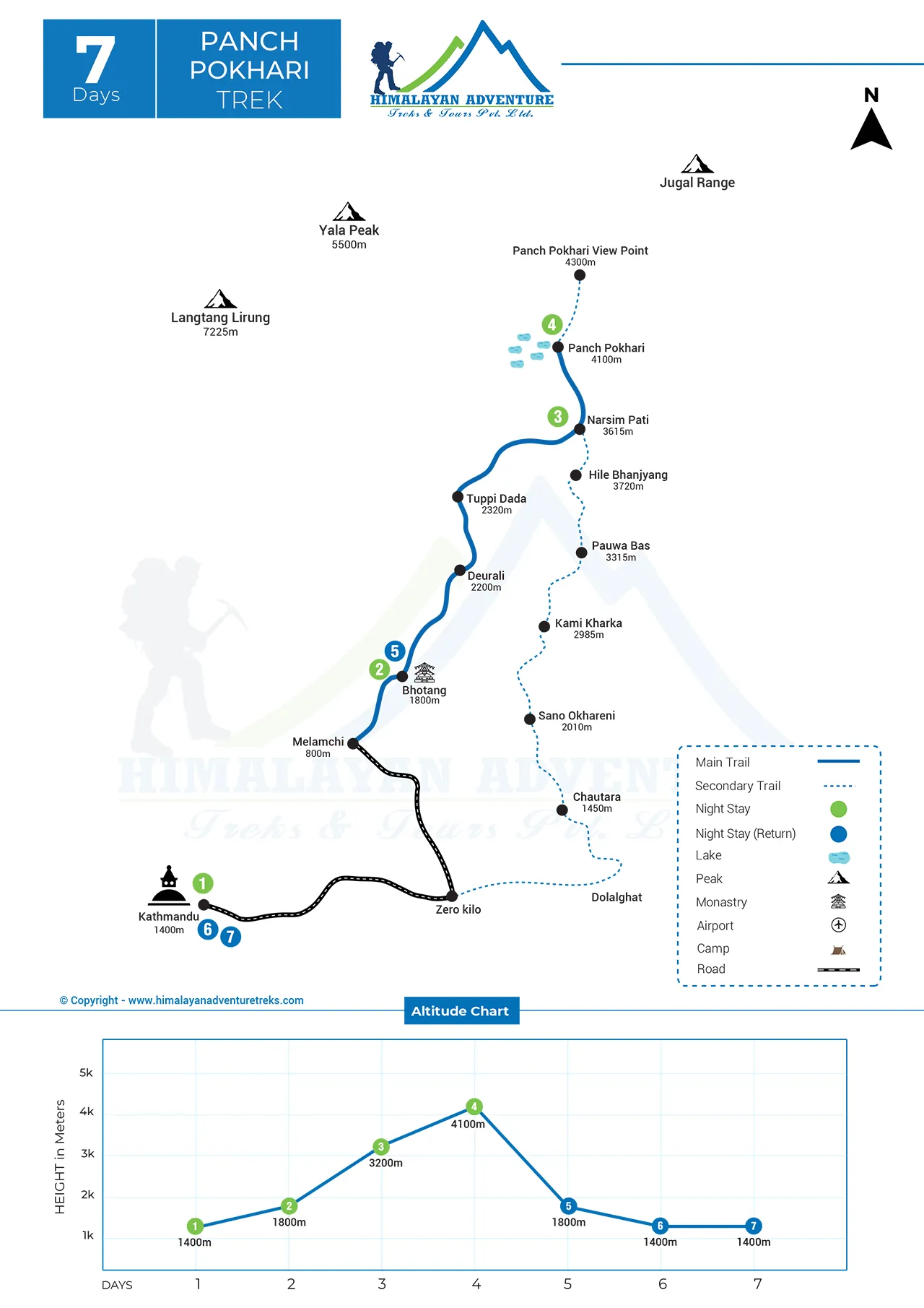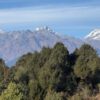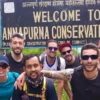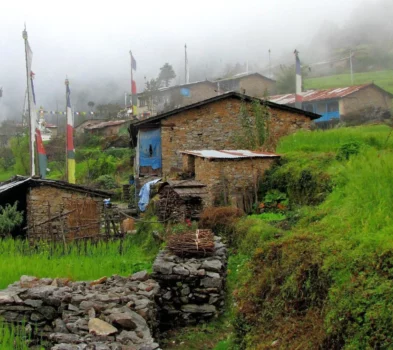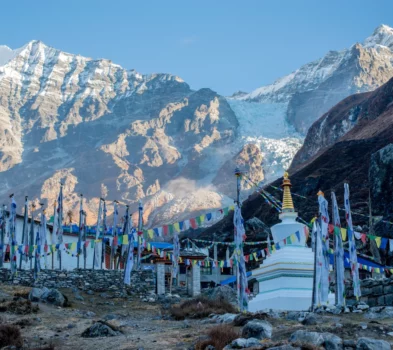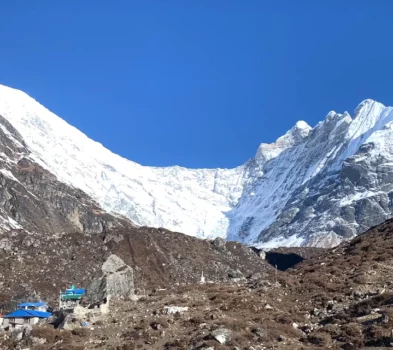Duration
7 DaysPanch Pokhari Trek
Trip Grade
ModerateGroup Size
1-16 PeopleMax Altitude
4,100m. / 13,451ft.Best Season
Feb- May/ Sept- NovActivity
Trekking and HikingMeals
Breakfast, Lunch & DinnerAccommodation
Hotels & TeahousesTransportation
Private Vehicle & JeepTrip Customization
On request (click here)Highlights of Panch Pokhari Trek
- Visit to five sacred alpine natural lakes above 4100m
- Stunning Himalayas views of mountain ranges, which include Langtang, Jugal, and Rolwaling ranges
- Off-the-beaten trail with peaceful, crowd-free trails
- Cultural encounters of the Tamang and Sherpa communities
- Diverse landscapes of forests, waterfalls, meadows, and alpine terrains
- Wildlife encounters in Langtang National Park, including rare species which are on the endangered list
Trip Introduction
The Panch Pokhari is named after the five sacred alpine lakes- Panch means five and Pokhari means lakes. Panch Pokhari lies in the Sindhupalchowk district of Nepal just northeast of Kathmandu valley, lies at an elevation of 4,100 meters, and is marked as the ninth highest altitude wetland system in the world.
The Panch Pokhari trek is a naturally amazing and spiritually uplifting journey that leads you deep into the pristine Himalayan region, offering one of the best journeys in mountain landscapes. This trek is just not a journey through dramatic landscapes and rugged trails but also a significant pilgrimage to one of the most esteemed Buddhist and Hindu plat in Nepal.
For the trekking enthusiast who is seeking an alternative to the crowded routes of Everest and Annapurna, the Panch Pokhari trek is the perfect choice. This trek offers unmatched tranquility, cultural immersion, and beauty of nature in just 7 days of timeframe. Despite being too close to Kathmandu Valley, this region is remarkably untouched which makes it ideal for those who crave raw authenticity and Himalayan adventure.
The Panch Pokhari trek begins with the scenic drive from Kathmandu to Bhotang, a beautiful traditional Tamang village (one of the ethnic groups of Nepal) that lies in Lap of green pastures and hills.
Your trek officially starts from this village, you will gradually ascend via verdant rhododendron forests, yak grazing meadows, and ridge-line paths that offer breathtaking views of various Himalayan ranges including Jugal Himal, Dorje Lakpa, Langtang Lirung, Tashi Lapcha, and Phurbi chhyachu.
The spiritual and cultural atmosphere accompanies you along the way which makes this trek unique and amazing. As Panch Pokhari is considered a holy site you can witness thousands of pilgrims in this place during the full moon festival of Janai Purnima.
It is believed that Lord Shiva on the Full moon day of Janaipurnima meditates at this lake taking a dip in the crystal-clear waters of the lake to purify the soul and grant blessings to his devotee. You can witness stone shelters and shrines built by the devotees and monks over centuries in this place.
The route of Panch Pokhari Trek is dotted with the remote villages of Tamang and Sherpa. You can experience Teahouse and homestay along the trail that is basic but outstanding and offers more than just accommodation but provides healing to the soul and cultural exchange where you can dine with local families, witness their lifestyle, taste traditional cuisine, and witness ancient culture and tradition untouched by modernism.
This trek offers you a chance to learn about the culture, tradition, rituals, spiritual values, and mountain resilience of the locals. So, this trek is just not a journey it’s a human connection across cultural and linguistic boundaries.
Though the trek reaches altitudes of 4,000 meters, the moderate grade and the gradual ascent make this trek easily accessible for experienced trekkers. This itinerary is well-paced for 7 days and includes ample time for acclimatization. The golden sunrise view over a ring glacial lake of Panch Pokhari and shining onto the distant Himalayas is breathtaking.
This place is just not rich in cultural immersion but also rich in numerous flora and fauna. In the spring, the trails come alive with the blooming of different colors rhododendron (national flower of Nepal), juniper, and various alpine wildflowers. If luck is on your side, you’ll witness various wildlife including Musk deer, Himalayan goats, Langurs, Himalayan Monal, and Yaks, making Panch Pokhari Trek an expectational blend of spring journey.
We have customized this 7-day Panch Pokhari Trek as a well-balanced package for couples, families, solo travelers, and small to big groups. This package is perfect for beginners, seasoned trekkers, adventure thrillers, and Himalayan experience seekers. This package is what you need to choose. This package promises to reward you with a lifetime experience and memories.
Outline Itinerary of Panch Pokhari Trek
Day 01: Arrival at Tribhuvan International Airport, Kathmandu (1,400 m)
Day 02: Drive to Bhotang Village (1,800m) from Kathmandu- Approx 6 to 7 hours.
Day 03: Trek from Bhotang to Nasimpati (3,800m) – Approx 6 to 7 hours.
Day 04: Trek from Nasimpati to Panch Pokhari (4,100m)-3 to 4 hours
Day 05: Trek back from Panch Pokhari to Bhotang (1800m)- approx. 7 to 8 hours.
Day 06: Drive from Bhotang village to Kathmandu (1400m)
Day 07: Final Departure
Our guests sharing their experiences (Photo/Video Gallery)
Detail itinerary of Panch Pokhari Trek
Day 01: Arrival at Tribhuvan International Airport, Kathmandu (1,400 m)
Upon arrival at Tribhuvan International Airport Kathmandu, our airport representative will greet you and take you to the hotel where you are staying for today’s night.
After checking in to your hotel, you can take a rest for the day or you can do some last-minute shopping in Thamel for your tomorrow’s trek.
In the evening, we will host a welcome dinner party in authentic Nepali cuisine, there you will enjoy typical Nepali food and beverage with cultural shows. At the same time, you will meet your team members and your guide.
Your guide will brief you about your trek and you can also ask doubtful questions to your guide about Panch Pokhari trek. Overnight stay at a hotel in Kathmandu.
Day 02: Drive to Bhotang Village (1,800m) from Kathmandu- Approx 6 to 7 hours.
Today, after breakfast at your hotel in the morning you’ll drive to Bhotang village from Kathmandu to get inside the trail of Panch Pokhari trek. Your journey to Bhotang is quite long but worth traveling.
On the way, you will witness charming valleys, terraced hills, forests, snowcapped mountain peaks, and traditional settlements.
On the way to Bhotang a beautiful Tamang village you will pass via Melamchi, a town for its hydroelectric projects, drinking water in the Kathmandu project, and farmland.
After reaching Bhotang, you can take a rest or you can explore the village, interact with locals, and enjoy delicious typical Nepali-style food. Overnight stay at Teahouse.
Activity: 6-7hrs drive
Max. Altitude: 1,800m/5,906ft.
Meal: B L D
Accommodation: Teahouse
Day 03: Trek from Bhotang to Nasimpati (3,800m) – Approx 6 to 7 hours.
Your trek officially starts, after an early breakfast in Bhotang. The trail starts with gradual inclines but eventually becomes steeper as you ascend through beautiful pine and rhododendron forests.
This part of the trek is a true blessing, you will witness chirping birds in the jungle, vibrant greenery, a view of snow-capped mountains, the soothing sound of the river, and if lucky you’ll witness wild animals including leopards, the small streams and wooden bridges add a dash in your trek.
As you ascend the environment gradually becomes isolated and pristine. After reaching ko Nasimpati, a high-altitude rest stop, offers stunning views of Jugal Himal and Langtang ranges if the weather supports and you can perfectly acclimatize under the dark sky. Overnight stay at a teahouse.
Activity: 6-7 hrs trek
Max. Altitude: 3,800m/12,467ft.
Meal: B L D
Accommodation: Teahouse
Day 04: Trek from Nasimpati to Panch Pokhari (4,100m)-3 to 4 hours
Today’s trek is the most special, sacred, and anticipated day of your entire journey. The tail ascends steadily through alpine meadows and barren landscapes. As you get closer, the flattens, and the five holy lakes- Panch Pokhari- start reveling themselves like jewels nestled among rugged hills.
Each lake has its spiritual significance, and all together they form a powerful pilgrimage site that draws thousands of devotees during Janai Purnima, the biggest Hindu Festival held in August.
After reaching Panch Pokhari you will witness a small shrine and simple temple of Lord Shiva surrounded with symbolic prayer flags near the tranquil lake. The environment of the lake is soul-soothing, with holy water reflecting the snow-covered mountain peaks, the prayer flags fluttering in the wind, and a silent spiritual reflection.
You can hike to a nearby ridge from the lake to witness an eye-catching view of Various Himalayan peaks, stretching from Langtang to Gauri Shankar and Rol walling ranges. Overnight stay at a tea house.
Activity: 3-4 hrs trek
Max. Altitude: 4,100m/13,451ft.
Meal: B L D
Accommodation: Teahouse
Day 05: Trek back from Panch Pokhari to Bhotang (1800m)- approx. 7 to 8 hours.
After an early breakfast in Panch Pokhari, you’ll look at the sacred lakes full of your eyes and begin your walk toward Bhotang. The trail retraces your steps but offers a completely different perspective.
You’ll be walking via the rhododendron forest which is one of a highlighted feature of Panch Pokhari Trek. The walk is long but while walking you’ll enjoy the soothing sound of the river, bird creeping, and beautiful view of the valley which is more than enough to make your day satisfying.
Morning light filtering through the rhododendron trees, the distant views of river valleys, and the peaceful rural path make this a very satisfying day. Overnight stay at a teahouse.
Activity: 7-8 hrs trek
Max. Altitude: 1,800m/5,906ft.
Meal: B L D
Accommodation: Teahouse
Day 06: Drive from Bhotang village to Kathmandu (1400m)
After breakfast in peaceful Bhotang Village, the Himalayas back carry memories and you will ride back to Kathmandu. The ride from Kathmandu to Bhotang is approximately 6 to 7 hours through Nepal’s beautiful middle hills.
You’ll pass through rugged mountain roads forested slopes, terraced farmlands, and traditional Tamang villages. On the way, you’ll enjoy a final glimpse into the rural lifestyle of Sindhupalchowk.
The route to Kathmandu offers spectacular landscapes like terraced farmlands, dense forests, river valleys, and winding roads along hillsides. You will pass through Melamchi Bazaar, the main market of Sindhupalchowk district, where you will take a rest and get lunch or grab some refreshments.
After you arrive in Kathmandu, your driver and guide will drop you to your hotel. The rest of the day is yours. You can relax at your hotel or you can explore the market of Thamel for shopping where you can buy Nepali authentic souvenirs as a gift to yourself or for your loved ones.
In the evening, we will host a farewell dinner at a typical Nepali restaurant where we will cheer for your experience and memories of the Panch Pokhari trek. Overnight stay at a hotel in Kathmandu.
Day 07: Final Departure
Today is your last day in Nepal, for the itinerary of the Panch Pokhari trek, if you want to extend your stay in Nepal, you can let us know we can customize another package as your reference.
Otherwise, our airport representative and driver will take you to Tribhuvan International Airport (TIA) for your departure as per your flight schedule. Had a great time with you in Nepal, wish to serve you again on your next vacation, till then have a safe and wonderful journey. Goodbye from Nepal!
Note:
If you have your own private group and want to make your trip private, we can run the custom trip all the day as per your requirements and group size.
Includes and Excludes
What are included with package?
- Pick up from Airport and Transfer to the hotel: Upon arrival, you will be picked up from the airport and transferred to your hotel in Kathmandu.
- Two Night 3-star hotel in Kathmandu with breakfast: Accommodation in a 3-star hotel in Kathmandu with breakfast provided for two nights.
- Lunch, dinner, and breakfast during trekking: All meals (lunch, dinner, and breakfast) are included during the trekking days.
- National park permit: Necessary permits to enter national parks and protected areas during the trek are provided.
- Trekkers’ Information Management System (TIMS) Permit: TIMS Permit, which is required for trekkers, is included in the package.
- Kathmandu to Bhotang Village and Kathmandu by private vehicle: Private vehicle transport is arranged for the round trip between Kathmandu and Bhotang Village.
- All necessary paper works: All required paperwork, including permits and documentation, will be taken care of for the trek.
- All accommodation during the trek in Teahouse and Home stay: Accommodation during the trek will be in teahouses and homestays, offering local and cultural experiences.
- An experienced, helpful, and friendly Guide, porters (1 porter for 2 clients): An experienced guide will accompany you throughout the trek, and a porter will be provided for every two clients to carry luggage.
- Travel and rescue arrangements: Arrangements for travel insurance and rescue services in case of emergencies are included.
- Medical supplies (first aid kit will be available): A first aid kit will be available during the trek, ensuring that you are prepared for minor health issues.
- Last night’s farewell dinner at an authentic Nepalese restaurant with a cultural performance: On the final night, a traditional Nepalese farewell dinner with a cultural performance will be arranged as part of the experience.
What are not included with package?
- Nepal Visa fee: You can easily obtain your Nepal visa upon arrival at Kathmandu airport. The fee depends on the duration of your stay.
- International airfare to and from Kathmandu: The cost of your international flights to and from Kathmandu is not included in the package and must be arranged separately.
- Travel and rescue insurance: It is essential to have travel and rescue insurance that covers trekking activities, which is not included in the package.
- Personal expenses: Any personal expenses such as phone calls, laundry, bar bills, battery recharge, extra porters, bottled or boiled water, hot showers, and other personal items are not included in the package and will be at your own cost.
Pick Your Suitable Date
Book a Private Trip
Private & Group Discount Price
-
1 -
1 person
US$ 1200
-
2 -
2 people
US$ 700
-
3 -
5 people
US$ 650
-
6 -
10 people
US$ 600
-
11 + people
9999
US$ 500
Total Cost:
US$ 1200
Route Map & Altitude Chart
Kathmandu
Start/End point
Kathmandu
Trip Information
Best Time
The Panch Pokhari trek is a breathtaking off -the -beaten -path route that can be done in every season, but the perfect time to trek to Panch Pokhari is spring season (April to early June) and Autumn Season (September to early November). The climate remains stable in these seasons, with clear skies and perfect views of the snowcapped Himalayan peaks. Trails remain dry and more approachable, which makes the trek secure.
Spring is the act of flowering and a vibrant environment, while autumn offers cultural big festivals in the whole country and crystal-clear views of snowcapped stunning mountains. In this season you feel different vibes in the air.
The summer season (June to August) is also possible for the trek, but slippery trails, leeches, frequent rain, and cloud cover hide mountain views
Winter Season (late November to March) very cold at high altitudes and snowy
During winter in Panch Pokhari Trek, snow can block paths so it’s better to avoid it unless you are an experienced trekker. The temperature drops below -10°C at night, especially near the lakes. But the trek can be done with proper gear and a reliable support team and only if you are an experienced trekker.
Quick Overview
Best time: April-June, September–November
Possible but less ideal: June – August
Not recommended: Late November- March (chances of snow and cold)
Accommodations are available while trekking Panch Pokhari
The Panch Pokhari trek is an isolated and less-commercialized trekking route, so the accommodation in this route and limited compared to more popular trekking routes like Annapurna and Everest.
The Basic Options available are:
Tea Houses and Local Lodges
- Along the route, you’ll find a few tea houses and small lodges in villages like Chautara, Deurali, Kami Kharka, Pauwa Bas, Hile Bhanjyang, and Narsim Pati. These are normal accommodations usually run by local families.
- Rooms are basic with twin beds or dormitory setups.
- Bedding may be provided, but it’s recommended to bring your own sleeping bag.
- Toilets are mostly shared and squat-style.
- Hot showers are rare, sometimes available via bucket or solar heating.
Lodges in Panch Pokhari
- At Panch Pokhari (the Five Sacred Lakes), there are also basic lodging facilities. Local lodges or temporary shelters are available, especially during the pilgrimage season.
- A well-known lodge operator in the area is “Sonam & Tungna Hotels,” which has lodges in Deurali, Norshyam Pati, and Panchpokhari itself. These places offer basic rooms and food.
Camping Options
If you’re trekking with a guide or group, especially during off-season, you might need to camp at certain points. Tents, food, and cooking arrangements are usually handled by our company.
Meals
- Foods are authentic and typical local style. You can expect dishes like:
- Dal Bhat (rice and lentils)
- Noodles, soup, or Tibetan bread
- Tea and coffee
- There are no fancy restaurants or menus, so it’s best to go with basic expectations.
Electricity & Internet
- Charging your devices may be possible in the lower villages, but it is unreliable.
- There is no Wi-Fi. Mobile networks (NTC or Ncell) may work in some areas, but the signal is weak or nonexistent in higher regions.
Notes to consider:
- Accommodations are basic tea houses and local lodges.
- Don’t expect luxury – carry a warm sleeping bag and some snacks.
- Lodges are usually available throughout the trail but may be limited near the lakes.
- Camping is a backup option in remote areas.
- Meals are simple but fulfilling.< /li>
Preparation and Fitness for Panch Pokhari Trek
These 7 days Panch Pokhari Trek is considered moderate in difficulty and doesn’t reach very high altitudes (max. 4,100 meters at the lake). It doesn’t require technical mountaineering skills, good physical preparation and smart planning are essential for an enjoyable and safe experience.
Fitness Requirements:
You don’t need to be a sports or athletic person, but good health is on top.
If you truly want to do the Panch Pokhari trek we recommend you start trainings like hiking, stair climbing, and aerobic workouts like cycling and jogging for about 30–45 min, 3–4 times/week.
Practice carrying a light backpack during training to simulate trek conditions.
Mental Preparation:
- You need to make up your mind that you won’t find any luxury, you will be accommodated in basic (shared toilets, limited hot water)
- Changes in weather and trail conditions
- Limited internet/mobile coverage
Packing Tips:
- You must not forget to bring quality trekking gear, like you need to carry firstly first aid kit, a down jacket, a sleeping bag, warm layers, and trekking boots.
- As shops are sacred, you must carry light snacks, power banks, water bottles, towels, etc.
- Sandals or slippers for the teahouse use
Altitude Awareness:
- Although the Panch Pokhari Trek stays below major high-altitude danger zones, altitude can still affect you above 4100m.
- Keep yourself hydrated and ascend carefully.
- Avoid alcohol and smoking during the trek.
- Rest properly and eat balanced meals.
- Carry a first aid box including Diamox.
Altitude Sickness and Precautions
The Panch Pokhari is situated at an altitude of 41,00 meters (13,451) above sea level. This trek offers breathtaking views of stunning snowcapped mountains, beautiful landscapes, an isolated village experience, but the high altitude poses a risk of altitude sickness-Acute Mountain Sickness (AMS).
Common Symptoms of Altitude Sickness:
- Headache
- Nausea or vomiting
- Dizziness
- Fatigue
- Shortness of breath
- Loss of appetite
- Trouble sleeping
What are the risks while trekking to Panch Pokhari
Since Panch Pokhari lies above 4,000 meters, the risk of AMS is real, especially if:
- You ascend too quickly without proper acclimatization.
- You don’t stay hydrated.
- You ignore early symptoms and continue climbing.
Unlike more popular treks (like Everest Base Camp), the Panch Pokhari trek has limited infrastructure, fewer teahouses, and more remote sections. This makes immediate medical assistance more difficult, so prevention is essential.
Tips to Prevent Altitude Sickness
Ascend Slowly: Follow a gradual itinerary. Avoid gaining more than 500 meters in sleeping altitude per day above 3,000 meters.
Acclimatize Properly: Take a rest or acclimatization day around 3,300–3,400 meters if possible.
Stay Hydrated: Drink 3–4 liters of water daily.
Avoid Alcohol & Smoking: These can worsen dehydration and AMS symptoms.
Eat Well: Maintain good nutrition for energy and recovery.
Listen to Your Body: If you feel unwell, do not ascend further. Rest, and descend if symptoms worsen.
Medication
Acetazolamide (Diamox): Can be taken preventatively or to reduce symptoms. Always consult a doctor before the trek.
Ibuprofen/Paracetamol: For headaches, but not a substitute for descent if symptoms worsen.
Note: Reaching the elevation of 4,100 meters means altitude-related risks must be taken seriously. With the right preparation, pace, and respect for the mountains, you can safely enjoy this lesser-known Himalayan gem.
Permits
Usually, we take all the permits for our clients, but you should know that the Panch Pokhari Trek falls within the Langtang National Park region and some parts of the Sindhupalchok district, making it necessary to obtain certain permits before starting your trek. These documents help regulate tourism, support conservation efforts, and ensure trekkers’ safety in remote Himalayan regions.
Required Permits
1. Langtang National Park Entry Permit
Since a significant part of the Panch Pokhari trail lies within the Langtang National Park, this permit is mandatory.
Cost:
- NPR 3,000 (approx. USD 25) for foreigners
- NPR 1,500 for SAARC nationals
Where to Get It:
At the Nepal Tourism Board (NTB) office in Kathmandu (Pradarshani Marg) or we can take a permit for you.
Documents Required:
- Copy of your passport
- Two passport-sized photos
2. TIMS Card (Trekkers’ Information Management System)
The TIMS Card is a trekking record system managed by the Trekking Agencies Association of Nepal (TAAN) and the Nepal Tourism Board. It is used for the safety and management of trekkers in the mountains.
Cost:
- USD 20 for individual trekkers
- USD 10 for group trekkers (if you’re with a registered agency)
Where to Get It:
NTB office in Kathmandu or TAAN office in Maligaon
Documents Required:
- Passport copy
- Passport-sized photos
- Itinerary and travel insurance details
Note: As of 2023, solo trekkers are required to hire a licensed guide for most trekking regions in Nepal, including Panch Pokhari. Check the latest government policy updates before applying.
Important Notes
- No technical climbing skills are required for the Panch Pokhari trek
- Suitable for beginners with moderate fitness
- Hiring a local guide or porter is highly recommended for route support, safety, and cultural insights
Essential Packing Gear List for Panch Pokhari Trek
If you have decided to go on the easy short trek, the Panch Pokhari Trek in Nepal, we assure you that you will have a fantastic time ahead. But what should you pack for your Adventure? What will be the right gear to make your trip more fabulous? To help you with this, we have compiled a packing list of essential items that you mustn’t forget to bring along.
- Passport ( min 6 months valid)
- Cash, credit card
- List of important addresses and contact details
- 2-3 passport photos (optional)
- Copies of all important travel documents (passport, visa, airline ticket, insurance policy, etc.)
- A sturdy 70 L trekking backpack which will be carried by your porter (please note that our assigned 1 porter will carry 2 clients’ luggage up to 20-25 kg.
Note: We will provide each participant with a spacious 70 to 75 L Company logo duffle bag to conveniently carry your trekking gear, which you have to return once the trek is complete. - A 30 L Daypack that has room for your essentials such as camera, mobile, Passport, important documents, water bottle, day use medicine, chocolate bars, raincoat, etc., which will be carried by you.
- Protective cover for a backpack or travel bag.
- Hiking Boots: Preferably ankle-high boots to prevent ankle sprain
- Regular Shoes: For small strolls and exploration around the city
- Second, a light pair of shoes and possibly sandals
- Micro Spikes or Ice Cleats for the winter trekking over snow and ice
- Gaiter for added protection in snow
- A rain and wind-resistant, lightweight down jacket for warmth, with a good helmet hood
- Summer-light, as well as winter warm clothing
- Quick-drying shirts made of synthetic fabrics
- Warm and cool vests or T-shirts
- Functional synthetic underwear
- Sports Bra for Female Trekker
- A waterproof pair of trousers
- Regular trousers of quick-drying fabric
- Hiking shorts
- Cargo Pants with multiple pockets to hold your small items, such as knives or chocolates
- Woolen or fleece pants
- Trekking socks, both thick and woolen fabric, and lighter wool socks
- Wool hat, gloves, and scarf
- A light cotton scarf or a bandanna for protection of your head, neck, ears, and mouth
- Sun hat, and sunglasses with 100% UV protection (for trekking trips, even with stray light and nose protection)
- Sunscreen cream or lotion with a high sun protection factor (at least 15, for trekking trip,s even at least 30)
- Sunscreen lipstick with a high SPF (at least 20, for trekking trips, even at least 30 or sunblock)
- Mosquito repellent (Optional)
- Comfortable light night clothes and shoes
- A drinking bottle that can be used as a hot water bottle on frosty nights
- Flip-flops or bathing shoes for using the showers
- Water purifiers: if you need to refill water from the tap or stream en route
- Headlamp: for a midnight or pre-dawn trip towards the viewpoint
- Quick-drying towel and sample-size toiletries for washing your feet and face
- Your Personal first-aid kit: with basic medical supplies such as bandages for sprains, antidiarrheal and antibiotics, iodine wipes for scrapes and cuts, plasters, aspirin, or ibuprofen, moleskine for preventing blisters, Diamox (acclimatizing medicine), and your Personal medication
- Sleeping bag appropriate for all-season treks (we can hire in Kathmandu)
- Waterproof money belt, chest bag, leg bag, or belt bag for storing important travel documents or valuables
- Toothpaste, Toothbrush, and soap
- Deodorants
- Moisturizer
- Nail clippers
- Feminine hygiene products (Sanitary Pads)
- Small mirror
- Wet wipes
- Hand sanitizer
- Comb
- Camera with sufficient memory cards and spare batteries, or a battery charger
- Small padlock for your travel bag
- Crampons ( during winter, Dec- Feb)
- Thermos flask
- Water bag
- Toilet paper (2-3 rolls without)
- Ear Plugs
- Matchbox, or lighter
- Compass or GPS
- Map
- Alarm clock
- Multi-tool kit
- Binoculars
- Books
- Whistle
Equipment Note:
- Please note that there is no need for you to bring all these heavy items, such as a Sleeping bag, a down Jacket, Trekking Poles, and items from your home. You can easily rent or purchase high-quality to standard-quality items in the Kathmandu Thamel area.
- Items are available from international brands such as The North Face, Sherpa Adventure, Marmot, Mountain Hardware, Black Yak, Karma Gear, and local brands like Goldstar and locally made products etc.
- Plus, we will also gift you a company logo T-shirt as a token of your experience in Nepal with us.
Renting Cost:
- Sleeping Bag & Down Jacket (-10-20 degree Celsius), Per Piece per day US$ 1.5
Frequently Asked Questions
Where is Panch Pokhari Trek located?
Panch Pokhari is located in the Sindhupalchok district of Nepal, northeast of Kathmandu, within the Langtang National Park region. Panch Pokhari trek is famous for its five sacred lakes situated at an elevation of about 4,100 meters.
How difficult is the Panch Pokhari Trek?
The Trek is considered as a moderate trek. It doesn’t require extreme experience or technical climbing. This trek is ideal for beginners with average fitness. Daily trekking lasts 5–7 hours on varied terrain.
What is the highest elevation of the trek?
The highest elevation of the Panch Pokhari trek is the lake area at 4,100 meters (13,451 feet) above sea level. There is also a viewpoint above the lakes at approximately 4,150 meters, which offers stunning panoramic snowcapped mountain views.
Do I need any special permits for the Panch Pokhari Trek?
Yes. You need to take a permit for the Panch Pokhari trek:
- Langtang National Park Entry Permit
- TIMS Card (Trekkers’ Information Management System)
We usually handle the permits for our clients.
Do I need a guide for the Panch Pokhari Trek or I can do solo?
No, you can’t do a solo trek in this area, it is strictly restricted by the Nepal government, trek through a registered trekking agency or hiring a licensed guide is recommended to enhance your experience with local insights, safety, and navigation support.
What is the best time to do the Panch Pokhari Trek?
The best times to do Panch Pokhari are:
- Spring Season (March to May) – clear skies, rhododendron bloom
- Autumn Season (September to November) – crisp air, great mountain views
Avoid the monsoon (June to August) due to rain, leeches, and slippery trails. Winter (Dec–Feb) is cold and often snow-covered but possible for experienced trekkers.
Are there teahouses or lodges on the Panch Pokhari trail?
Yes, you will stay in teahouses (basic lodges) run by local families. They offer clean rooms (usually twin-sharing), basic beds, blankets, and local meals.
Some villages may have access to hot showers and Wi-Fi for an extra cost. So, you need to be mentally prepared, no luxury will be found, you need to adjust, during the Panch Pokhari trek.
How long is the Panch Pokhari Trek?
The standard trek takes 7 days, including arrival and departure from Kathmandu. The trekking portion typically spans 5 days, depending on your pace and chosen itinerary.
Is altitude sickness a risk on Panch Pokhari trek?
Yes. Since the trek reaches 4,100m, there’s a risk of Acute Mountain Sickness (AMS). To prevent it:
- Ascend slowly
- Stay hydrated
- Take acclimatization breaks
- Consider carrying Diamox after a medical consultation
Is there a mobile network and electricity during the trek?
Mobile network coverage is very limited after leaving Bhotang.
Electricity is available in villages for charging devices, often solar-powered. Carrying a power bank is recommended.
Do I need travel insurance?
Absolutely. You must have travel insurance for the Panch Pokhari Trek that covers:
- Emergency helicopter evacuation
- High-altitude illness
- Medical care and trip cancellations
This is essential for safety in such remote regions.
Why should I choose the Panch Pokhari Trek over other popular treks?
If you’re looking for:
- Peaceful, crowd-free trekking
- A mix of spiritual, cultural, and natural elements
- Sacred Himalayan lakes not spoiled by tourism
- A moderately challenging trek within one week from Kathmandu
Then Panch Pokhari trek is perfect for you.

